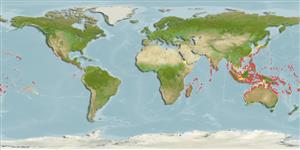Preferred temperature (Ref.
123201): 24.7 - 29.3, mean 28.3 °C (based on 2746 cells).
Phylogenetic diversity index (Ref.
82804): PD
50 = 0.5078 [Uniqueness, from 0.5 = low to 2.0 = high].
Bayesian length-weight: a=0.00089 (0.00039 - 0.00204), b=3.00 (2.80 - 3.20), in cm total length, based on LWR estimates for this (Sub)family-body shape (Ref.
93245).
Trophic level (Ref.
69278): 4.1 ±0.58 se; based on food items.
Widerstandsfähigkeit (Ref.
120179): mittel, Verdopplung der Population dauert 1,4 - 4,4 Jahre. (Preliminary K or Fecundity.).
Fishing Vulnerability (Ref.
59153): High to very high vulnerability (72 of 100).
Nutrients (Ref.
124155): Calcium = 27.8 [14.5, 50.8] mg/100g; Iron = 0.436 [0.258, 0.977] mg/100g; Protein = 19 [17, 22] %; Omega3 = 0.0994 [, ] g/100g; Selenium = 42.9 [23.9, 87.3] μg/100g; VitaminA = 46.6 [14.5, 139.1] μg/100g; Zinc = 0.787 [0.562, 1.112] mg/100g (wet weight);
